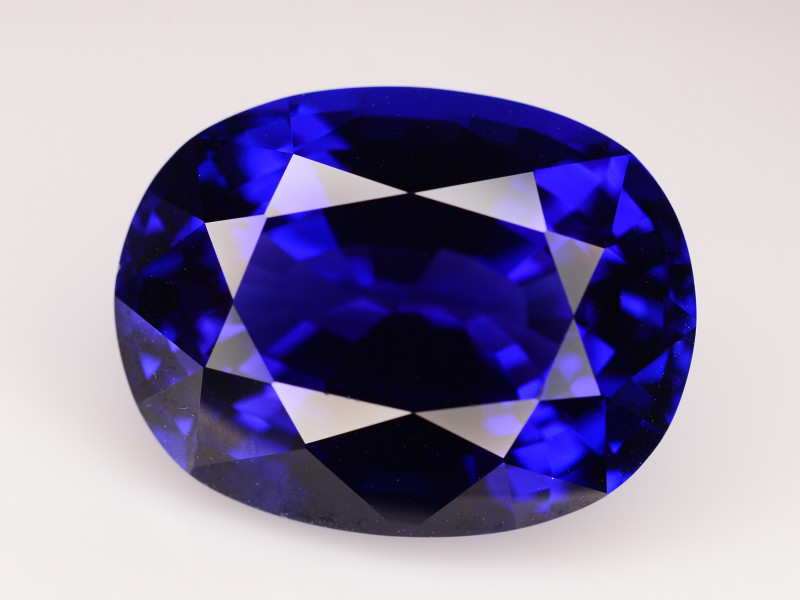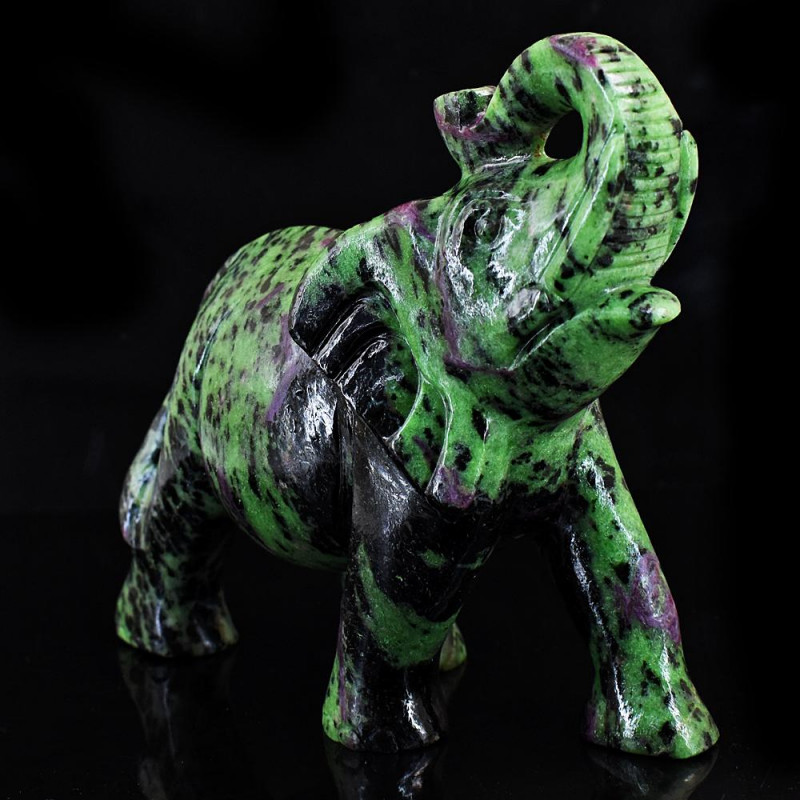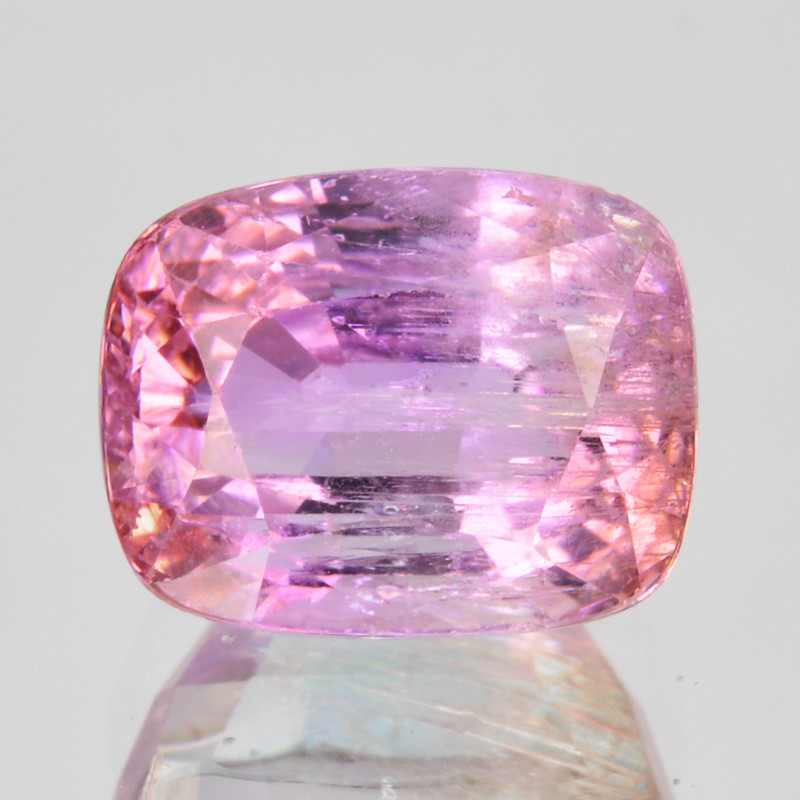Zoisite Gemstone: Information, Properties, Value & Pictures
 Zoisite (zow·uh·site) is a typically transparent gemstone with multiple different colored varieties, including multi-colored stones. The most popular variety is the lush violet-blue tanzanite. Discovered in the 1800s, zoisite has gradually taken the jewelry world by storm, particularly the zoisite tanzanite.
Zoisite (zow·uh·site) is a typically transparent gemstone with multiple different colored varieties, including multi-colored stones. The most popular variety is the lush violet-blue tanzanite. Discovered in the 1800s, zoisite has gradually taken the jewelry world by storm, particularly the zoisite tanzanite.
Some examples of famous zoisite appearances are Beyonce’s tanzanite ring and Sarah Jessica Parker’s Namunyak tanzanite pendant from her 2016 partnership with Kat Florence. Namunyak means “blessed” in the Kenyan Samburu language.
Now, is zoisite rare? Zoisite comes from quite a few places but only in small amounts, so it’s fairly rare. However, zoisite gems aren’t as rare as the tanzanite variety.
Want to learn more? This guide will teach you all about zoisite benefits, jewelry, prices, and more!

About Zoisite Stone
Zoisite gemstones originally went by “saualpite” starting in 1797 until they had a name change in 1805. What is zoisite used for? Unlike many minerals, zoisite uses are exclusive to ornamental items and jewelry.
As of 2002, the zoisite variety tanzanite is an official December birthstone. Summer babies can also get in on the fun, as zoisite is a zodiac stone for Gemini!
Maybe your birthday passed but you’re celebrating an anniversary soon. In that case, tanzanite is the traditional 24th wedding anniversary gemstone and an alternative 8th-anniversary gem!
Zoisite Specifications & Characteristics
Zoisite is a calcium aluminum silicate with an intense formula: Ca2Al3(SiO4)(Si2O7)O(OH). The stone is a polymorph (same composition, different crystal system) with clinozoisite.
The gem used to be considered an epidote variety until the International Mineralogical Association (IMA) classified all epidotes as having monoclinic crystal systems.
All the zoisite properties are listed below:
Mohs hardness: 6-7
Color: Can be solid, bi-colored, or multi-colored; Colorless, white, gray, green, brown, yellow, red; Violet-blue, blue, or purple (tanzanite); Pink (thulite)
Crystal structure: Orthorhombic
Luster: Vitreous (glass-like), pearly on cleavages
Transparency: Transparent to opaque
Refractive index: 1.69-1.70
Density: 3.10-3.37
Cleavage: Perfect on [010], Imperfect on [100]
Fracture: Conchoidal to uneven
Streak: White
Pleochroism: Strong in light pink to deep magenta, colorless to hot pink or deep blue, and light yellow to yellow-green
Optical effects: Rarely chatoyancy (tanzanite)

Types of Zoisite
Despite zoisite’s range of colors on its own, including the vibrant green “chrome zoisite” hue, most people know its varieties better. Each zoisite gemstone variety has a significant connection to its original source.
Let’s start with the most popular variety: tanzanite!

Tanzanite
Tanzanite is a blue to purple zoisite variety named for its discovery in Tanzania in 1967. To this day, this gem is still only found in Tanzania. The blue coloring comes from the presence of vanadium.
However, tanzanite’s pleochroism means you’ll see blue, violet, and yellow or brown from different viewing angles! Among blue gemstones, tanzanite is only second in popularity after sapphire. Plus, this semi-precious gemstone ranks fourth in popularity overall after the three precious gemstones (diamond, sapphire, and ruby).

Anyolite (Ruby in Zoisite)
Anyolite is a green and pinkish-red stone sometimes containing black inclusions. It’s also called ruby in zoisite, Tanganyika artstone, or ruby zoisite.
The stone isn’t a mineral but a rock composed of multiple minerals: green zoisite, ruby crystals, and sometimes black to deep green pargasite. Therefore, anyolite isn’t technically a zoisite variety, but it is marketed as one.
Like Tanzanite, anyolite was first discovered in Tanzania but over a decade earlier in 1954. The name comes from anyoli, which means “green” in Masai, the language of the Kenyan and Tanzanian Maasai tribe.

Thulite
Thulite is a translucent to opaque, rose-pink zoisite variety rich in manganese. It’s also called manganoan zoisite, Norwegian thulite, or rosaline zoisite, and serves as Norway’s national gemstone.
Discovered in Telemark, Norway, in 1820, thulite’s name comes from Thule. Thule is a term in ancient Greek literature for a possibly mythical island said to be the farthest location north in ancient times. However, other sources claim Thule is an ancient name for Norway.
We’ve learned a bit about each variety’s history, but what about zoisite’s past? We’ll go over that next, along with zoisite’s spiritual meaning!

Zoisite Meaning & History
Mineral dealer Simon Prešern first discovered zoisite in Austria’s Saualpe Mountains in 1797 and dubbed it “saualpite.” Prešern sent his samples to Slovenian mineralogist Sigmund Zois, who realized it was a new mineral.
Zois then sent it to German mineralogist Abraham Gottlob Werner in 1805, who honored Zois by renaming it “zoisite.”
For the next two centuries, zoisite was known among jewelers as a decorative stone. When tanzanite was found in 1967, it shot into fame. Former Tiffany & Co. VP Henry Platt gave tanzanite its name, and the company had exclusive selling rights for a decade.
After Tiffany collected about 2 million carats of rough tanzanite, the Tanzanian government decided to open up the mines to other sellers in 1971.
Zoisite symbolizes transformation, discovery, and renewal. Some call it the “Stone of Return,” in the sense of coming back to your true self or what makes you happy.
On that note, what are the healing properties of zoisite?

Zoisite Healing Properties
All zoisites can be healing stones, and some zoisite metaphysical properties vary between varieties.
Common brown zoisites have the grounding, strengthening, and comforting benefits inherent to all brown gemstones. Meanwhile, pink gems like thulite can promote self-love and acceptance, and green gems like anyolite help with personal growth.
Plus, thulite and anyolite are both powerful heart chakra stones!
What does zoisite crystal do for physical and emotional healing?
Physical Healing
Zoisite is popularly used for supporting fertility, growth, and vitality. Crystal healers recommend zoisite for issues around the lungs, spleen, and pancreas. Anyolite is said to improve circulation, reproductive issues, and heart disorders.
Emotional Healing
Emotionally, zoisite is said to help with feelings of self-doubt, anger, and dejection, replacing these feelings with optimism and hope.
Creatives feeling a mental block can also use zoisite to reframe their mindset and approach their projects with a renewed sense of curious discovery.
Other purported benefits of zoisite include increasing focus, supporting self-reflection, and strengthening self-acceptance.

Zoisite Gemstone Properties
Like any gem, experts examine specific gemstone properties to determine each zoisite gemstone’s value. Some factors have more weight for specific varieties.
For example, clarity and transparency is important for tanzanite and zoisite but not for thulite and anyolite. Meanwhile, the unique mixture of colors in anyolite is somewhat exclusive to that variety.
The overall gemstone properties for zoisite are color, cut, clarity, carat weight, and treatments.
Color
Zoisite alone can be colorless or white, along with shades or mixtures of brown, yellow, orange, or green. Green zoisite is called “chrome zoisite,” as it’s colored by chromium.
Most zoisites are muted greenish-brown or brown hues, and any brown lowers value. Green zoisite often has black lines of hornblende, similar to anyolite. However, black inclusions on either will lower the value. Higher amounts of ruby and unique color patterns in anyolite will increase value.
The most valuable colors are violet-blue tanzanite hues. The rarest colors are, in order: solid green, pink, purple, gray, and bright yellow. Higher color saturation in any zoisites equals greater value.
Cut
Translucent to transparent zoisites are usually faceted, often in brilliant cuts for paler specimens and checkerboard cuts for intensely colored specimens. These are more common for high-end zoisite jewelry, thus more expensive.
Opaque or heavily-included zoisites become cabochons, beads, tumbled stones, or carvings. Anyolite carvings are particularly popular, though this variety may be faceted.

Clarity
Clarity, or the number of visible inclusions, has a categorical grading system for colored stones. Transparent zoisites fall under Type I, meaning they typically have no eye-visible inclusions, and these fetch the highest prices.
Common inclusions in zoisite are quartz, diopside, rutile, and sphene. Typical patterns are growth tubes, fluid-filled cavities, and fingerprint inclusions.
Carat Weight
Most zoisites in jewelry are under 20 carats, though some tanzanites are over 200 carats! Thulite and ruby are often available in larger sizes, but chrome (green) zoisite is typically under 5 carats. Rarer gems like tanzanite and green zoisite will fetch higher rates for larger stones.
Treatments
Zoisite is often treated, usually heating brown stones to be blue or purple. In fact, most tanzanite has been heat-treated! Luckily, the treatment is stable, though unheated Tanzanian tanzanites are slightly more durable.

Zoisite Formation & Sources
Miners find zoisites as massive minerals, prismatic crystals filling schist or marble veins, and crystals along the edges of pegmatites.
Zoisite forms during one of two processes:
Regional Metamorphism: Heat and pressure changing the texture and chemical composition of rocks over a large area
Hydrothermal Alteration: Shifts in pressure, temperature, and chemical composition of rocks from hot, mineral-rich water, followed by new minerals crystallizing inside the rocks
Where do zoisite gemstones come from?
Mining Locations
Though the rough is small, zoisite gemstone locations are abundant. Some locales are known for specific varieties, which we’ll include below:
Afghanistan
Australia (thulite)
Austria (anyolite)
Cambodia
Germany
Greenland (thulite)
India
Italy
Kenya (anyolite)
Madagascar
Mexico
Namibia (thulite)
Norway (thulite)
Pakistan (thulite)
Scotland
Sri Lanka
Switzerland
Tanzania (tanzanite, anyolite)
USA - Massachusetts, North Carolina, Washington
Tanzanite is exclusive to Tanzania, and this nation remains the top producer of anyolite.
Moving on, what prices should you expect for zoisite gemstones?

Zoisite Price & Value
Zoisite’s price varies broadly between different varieties and colors. Tanzanite is the priciest, currently ranging from $200-$1,200 for good quality 1-carat gems and reaching $2,000 per carat for larger gems. On the other end, faceted anyolite gems are typically $2-$25 per carat.
Below, we’ll list the typical wholesale price ranges for different zoisite colors and cuts.
First, let’s look at faceted zoisite gemstones:
Anyolite: $2-$25 per carat
Pinkish-brown: $15-$20 per carat
Orange: $200-$300 per carat
Yellowish-brown: $200-$375 per carat
Yellow: Around $200 per carat
Pink: $500-$1,000 per carat
Onto cabochons, we’re looking at thulite and anyolite. Thulite cabochons are $0.10-$0.25 per carat. Next, let’s look at anyolite cabochon prices:
Fairly even mixture of ruby and zoisite: $0.50-$3 per carat
Mostly green zoisite: $0.40-$2 per carat
Large amount of black: $0.20-$1 per carat
Lastly, we’ll break down rough zoisite prices:
Anyolite: $0.10-$2 per carat
Yellow: $0.20-$1 per carat
Green: $0.30-$1 per carat
Thulite: $0.01-$0.10 per carat
Pink: $1-$7 per carat
After you’ve found your favorite gem, it’s time to learn how to take care of it.
Zoisite Care and Maintenance
Zoisite only has mid-range hardness, so choosing safe jewelry is an important part of gemstone care. Protective settings can keep vulnerable jewelry like a zoisite ring safer from breakage, along with any easily split anyolite jewelry.
You can clean zoisite with lukewarm water, mild soap, and a soft cloth. Remember to promptly dry it after.
Avoid zoisite gems contacting:
Ultrasonic or steam cleaners
Strong chemicals
Harsh soaps or detergents
High heat
Along with the list above, be sure to also keep anyolite stones away from sudden temperature changes, direct sunlight, and extreme cold.

Rekindle Your Passion & Zeal with Zoisite!
Though most people know tanzanite best, every variety of zoisite brings unique style, healing powers, and charm. Transparent zoisite jewelry is perfect for those who prefer a sophisticated, high-fashion style. Anyolite and thulite are great accessories or decor for a more bohemian, artisan look.
Regardless of the style, bringing any zoisite gemstone into your life can help you rediscover the talent and spark that makes you unique!
Shop for zoisite gemstones today!
Was this article helpful?
2 people found this article helpfulRoss Sedawie
- Written - 27th Apr 2022
- Edited - 5th Nov 2023

















